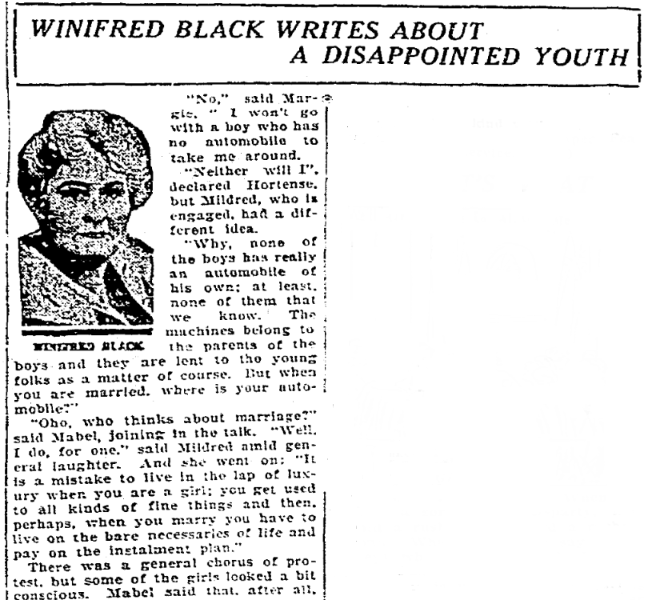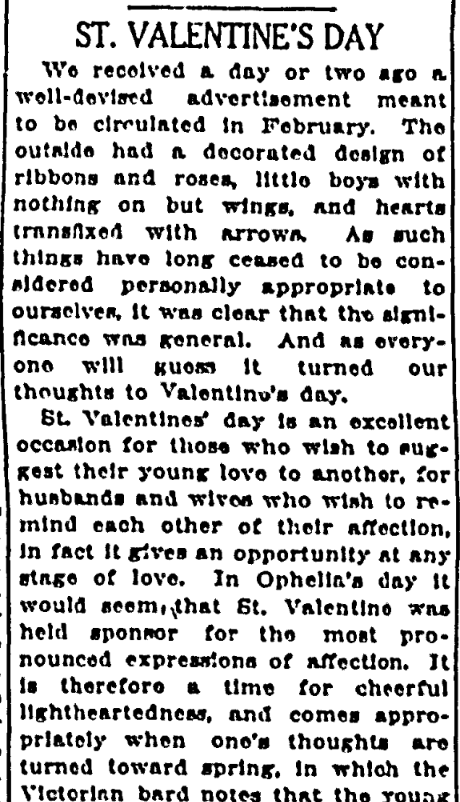Introduction: In this article – to help celebrate Valentine’s Day – Katie Rebecca Garner searches old newspapers to see what our ancestors thought of love 100 years ago. Katie specializes in U.S. research for family history, enjoys writing and researching, and is developing curricula for teaching children genealogy.
Marriage traditions have changed over the centuries. It is well known that arranged marriages were common long ago. Now, many cultures allow young people getting married to choose whom they will marry, and it is acceptable and even expected to choose someone out of love.
In the days of arranged marriages, love was not considered a good reason to marry. But what did people think of love 100 years ago? Let’s look at two newspaper articles on the subject that were published on Valentine’s Day in 1924.

Photo credit: https://depositphotos.com/home.html
Winifred Black, a newspaper writer in 1924, wrote an essay on love that was published in Albany, New York. She opened with a dialogue between young girls about what kind of boys they want to go out with. Margie said she would not go out with a boy who does not have a car to take her around. Hortense agreed. Mabel stated that she wants someone who can dance well. Margie said, “a good-looking beau was ‘all to the good’” but stuck to her first proposition that “an automobile was an indispensable appendage to any young man who sought her favor.”

Mildred, the only engaged girl in the conversation, brought up marriage. She pointed out that all the boys they knew did not have their own automobile but used their parents’ car, and that a newlywed couple was likely to be without an automobile. She advised against living in the lap of luxury as a girl because a newlywed couple would have to “live on the bare necessaries of life and pay on the installment plan.”
Somewhere in the conversation, Mabel said, “Oho, who thinks about marriage?” Mildred’s response was met with a chorus of protests. The author then stated that none of these girls, except Mildred, had “yet begun to think seriously of marriage, and I hope they will get a little wisdom before their wedding days come.”
This newspaper article shows that girls 100 years ago considered going out with boys without considering whom they would want to marry. This is an attitude that one might expect from young people who are old enough to find people of their preferred sexual orientation attractive but are too young to get married. This is as true now as it was 100 years ago.
Dating as we know it today was relatively new 100 years ago. In the early twentieth century, society shifted from courting to dating. Dating was freer for the young people involved than courting because courting had more parental involvement.
Winifred Black went on to say, “Certainly it is one thing to choose a dancing partner or a young man to take you driving in a handsome automobile. And another to select or accept a partner for life.” She explained how a girl does not think of getting a husband when she chooses a beau. She compared the qualities of driving a machine, being a good dancer, being a bright talker, or having good manners against a sense of honor. She advised looking for “the real qualities which you can love and respect in a man” and that “difficult places in life would be smoothed out” by looking at the fundamental things of existence.

Photo credit: https://depositphotos.com/home.html
This editorial about Valentine’s Day was published in Schenectady, New York, 100 years ago. It said:
St. Valentine’s Day is an excellent occasion for those who wish to suggest their young love to another, for husbands and wives who wish to remind each other of their affection; in fact it gives an opportunity at any stage of love.

This editorial went on to say:
In Ophelia’s day, it would seem that St. Valentine was held sponsor for the most pronounced expressions of affection. It is therefore a time for cheerful lightheartedness, and comes appropriately when one’s thoughts are turned toward spring, in which the Victorian bard notes that the young man’s fancy lightly turns to thoughts of love…
We fear, however, that Valentine’s Day has ceased to be more than an occasion. There was a time when St. Valentine as the patron of lovers prescribed uses and customs that will be remembered by the readers of “The Fair Maid of Perth.” Life had perhaps more forms and observances then than now, or at least paid more attention to them. At a more recent period Valentine’s Day inspired young men, and some older ones, to write copies of verses to the ladies of their affection. That was well because it served as one of the little amenities of life which are always pleasant and gracious. But now St. Valentine’s Day is little more than an occasion and an opportunity for those who (as far as we have observed) do not as a rule need much encouragement. Still even from that standpoint it will be looked upon by most people with benevolence.
In the twenty-first century, fewer people are dating than in the twentieth, and more people are choosing to stay single than in prior centuries. Some have given up on love, and some have not found the right person yet. Whatever the reason, Valentine’s Day is now also known as Single Awareness Day.
Based on the first article examined, even in days when people marry for love, marriage and love still have enough separateness for people to consider dating without considering marriage. The second article laments love becoming less formal, a trend that continues today. Attitudes toward love have not changed as much as one might suppose.
Explore over 330 years of newspapers and historical records in GenealogyBank. Discover your family story! Start a 7-Day Free Trial
Note on the header image: “Love & Valentine’s Day.” Credit: https://depositphotos.com/home.html
